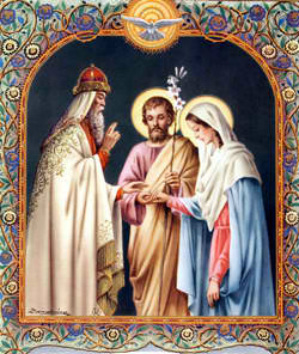
The order was that the candidates for Mary's hand should each deposit in the Temple over night a rod of almond tree. When the morning came and all were assembled at the place appointed, it was found that the smooth rod of Joseph, son of Jacob, had blossomed into beautiful flower and leaf. This sign was held by all as a testimony of Joseph's worthiness. Tradition goes on to say that another young candidate, Agabus by name, in despair at seeing himself put aside, broke his rod, left the world, and dedicated his life to God.
This legend is depicted by Raphael in his famous work, "The Marriage of the Virgin," preserved in the Brera, Milan. He represents the Jewish high priest joining the hands of Mary and Joseph, whilst Joseph places the ring on Mary's finger.
The Gospel words are few but precise. Mary is called "a virgin espoused to a man whose name was Joseph of the house of David." Joseph is a "just man," Mary's "husband," and Mary is his "espoused wife." Of the ceremonies of Jewish espousals and marriage at the time of our Lord, it would be easy to write a chapter, for many details are known of the customs of that day. But these are not to our purpose now. We want rather to look at St. Joseph "in the day of his espousals, in the day of the joy of his heart" (Can. of Can. 3, xi.).
Let us think of St. Joseph then. He would have in his heart the bounding joy of a lover beloved Mary, the Virgin of the Temple, had placed her hand in his. He was to wait but a few months to take her to a home of his own making, endow her with his fortune, nourish her with his earnings, protect her with his life. Though he knew the high aspirations of Mary's heart on the happy day of his espousals, he was far from understanding the wonderful destiny of his spouse. Little by little he learnt how sublime was his office, how exalted his charge. Like all great saints, he had to pass through a time of supreme agony, but the full light of Heaven changed a death-like fear into ecstatic wonder and admiration. He learnt from angelic lips that she whom he worshiped was the Spouse of the Holy Ghost, the Mother of the Son of God, of the Messiah of prophecy. And he was to stand aside like an angel guardian and become a virgin protector to a virgin mother, a foster-father to a heaven-born Babe. No' wonder we never hear St. Joseph speak, no wonder writers and painters have depicted him as old. He was grave, but his gravity was of thought, not of age; his silence was the fruit of meditation, not of senses dulled by years.
Think of the steps of St. Joseph's greatness. He began by the pure love of a spotless virgin. Gradually, as the mystery unfolded itself, the earthly love turned to enraptured veneration, and Mary became to him a trust from the God of his fathers, a divine treasure to be guarded from every shadow of ill. In the little cottage of Nazareth he was overflowingly happy. The months rolled on, and Cyrinus, governor of Judea, ordered the enrollment to carry out the decree of Caesar Augustus. Then Joseph journeyed with Mary to Bethlehem, and there in the stable at midnight received from her arms the Christ of God. Thus, from being Mary's spouse and protector, he became the foster-father of the Son of God. Through his love for Mary and his faithful service to her, he was found worthy to take that higher mission of Guardian of Jesus, This is why on today's feast St. Joseph is particularly commemorated. For him it was the beginning of his happiness, the first step to his unrivaled dignity.
~Manual of the Holy Catholic Church, Imprimatur 1906~
There is a coloring picture to be found here:


 RSS Feed
RSS Feed